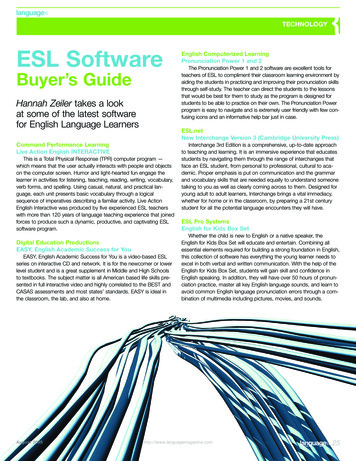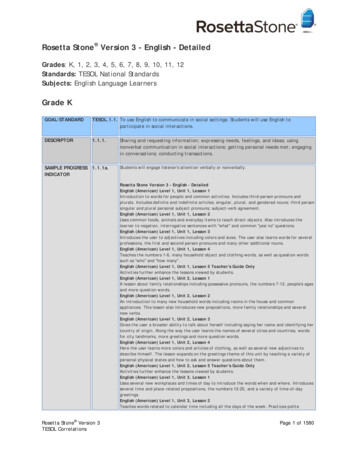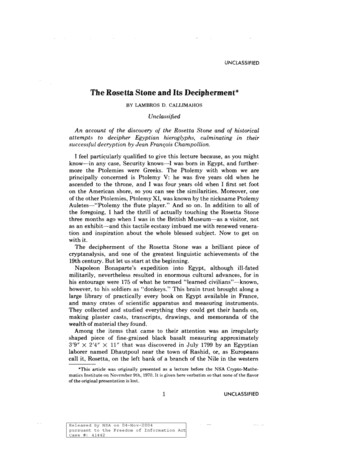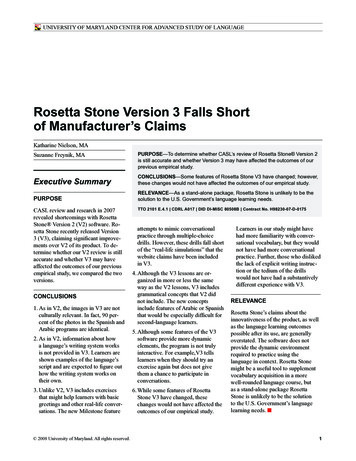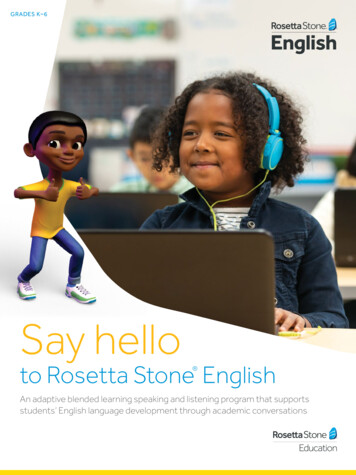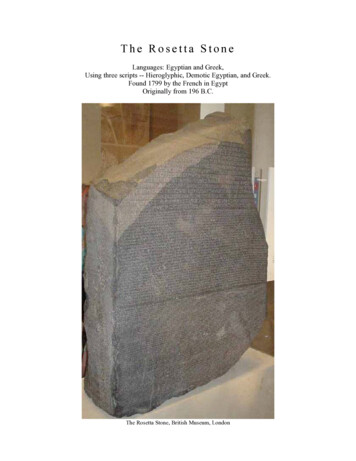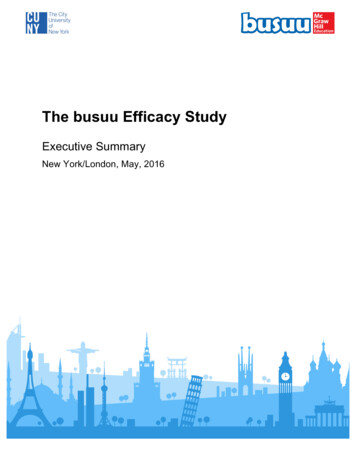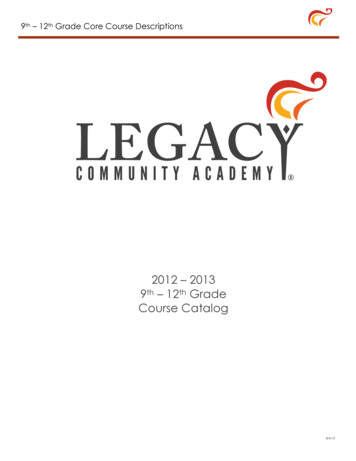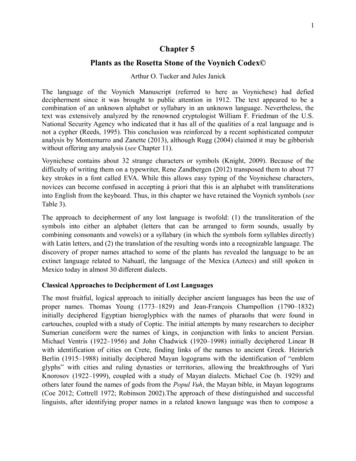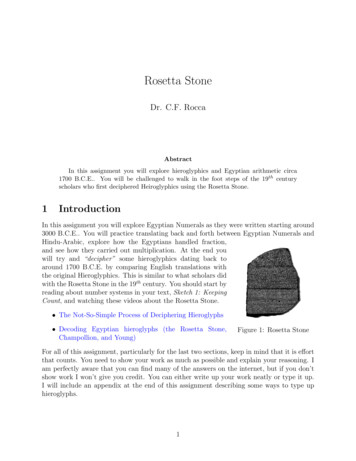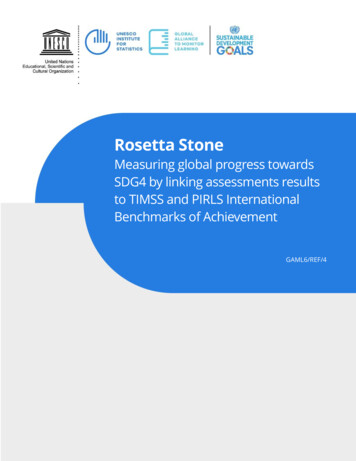
Transcription
Rosetta StoneMeasuring global progress towardsSDG4 by linking assessments resultsto TIMSS and PIRLS InternationalBenchmarks of AchievementGAML6/REF/4
2GAML6/WD/3Measuring digital literacy skills: SDG indicator 4.4.2
IEA’s Rosetta StoneMeasuring global progress toward the UN Sustainable Development Goal forquality education by linking regional assessment results to TIMSS and PIRLSInternational Benchmarks of AchievementIEA, December 19, 2018International Association for the Evaluation of Educational AchievementIEA Amsterdam Keizersgracht 311, 1016 EE Amsterdam, The Netherlands Tel. 31 (0)20 625 36 25 Fax 31 (0)20 420 71 36 secretariat@iea.nl www.iea.nlKvK 41158871
Contents1.Summary . 32.Introduction . 33.Implementation. 44.Study management and coordination . 55.Potential timeline . 66.Survey operations . 77.Scaling methodology . 78.Related documents . 82
1.SummaryThis proposal presents a strategy for providing information about the proportions of primary school studentsthat have achieved established proficiency levels in literacy and numeracy. The aim is to establish a linkbetween the results of regional assessments conducted at the primary level, and the TIMSS and PIRLSachievement scales for numeracy and literacy.There are five regional assessments currently planning reading and mathematics assessments targeted atthe end of primary schooling in 2019. This proposal suggests to start working with the regional assessmentERCE – the Fourth Regional Comparative and Explanatory Study, conducted in 19 Latin American andCaribbean countries.ERCE, the reading and mathematics assessment planned for 2019, provides a perfect opportunity to link theresults from a regional assessment to IEA’s TIMSS and PIRLS achievement scales. ERCE measures achievementat the sixth grade.1 The content of ERCE is expected to align well with the TIMSS fourth grade assessments innumeracy and mathematics; likewise, the reading component of ERCE is expected to align well with the PIRLSfourth grade assessment in literacy and reading comprehension.The overarching goal is to construct a concordance table that “translates” the scores resulting from ERCE inmathematics and reading to scores on TIMSS and PIRLS, respectively. The concordance table would thereforerepresent the “Rosetta Stone”, analogous to the original Rosetta Stone which provided a link between Greekand Egyptian hieroglyphics, providing a translation between countries’ ERCE results and the TIMSS and PIRLSachievement scales. Countries participating in ERCE can then use the translations to determine percentagesof their students that could be expected to reach the TIMSS and PIRLS international benchmarks or any otherbenchmarks that can be measured on the TIMSS and PIRLS scales2. Only three to five countries would needto administer the linkage material in order for all participating countries to be able to use the concordancetable – four countries are proposed for the main data collection cycle in 2019.2.IntroductionThe IEA provides countries with important trend results about their students’ reading literacy andmathematics and science achievement in a global context. The IEA’s TIMSS (Trends in InternationalMathematics and Science Study) and PIRLS (Progress in International Reading Literacy Study) areinternational large-scale assessments aiming at helping countries make informed decisions about how toimprove teaching and learning in their national context. More than 70 countries are participating in the IEA’sTIMSS 2019, which has regularly assessed mathematics and science achievement at grades 4 and 8 since1995. More than 60 countries participated in the IEA’s PIRLS 2016, which has regularly assessed readingachievement at grade 4 since 2001. To encourage participation by a broad range of countries, the IEA’s TIMSSand PIRLS use mathematics and science assessments of different difficulty designed to match the educationalachievement of students from countries at different stages of development in terms of their education1ERCE also measures achievement in lower grades. However the assessed grade level is different (3rd grade for ERCE).Linking TIMSS and PIRLS to the 6th grade for those regions which are expected to have mainly significantly lowerachievement levels compared to the TIMSS/PIRLS averages is deemed as most appropriate.2Please have a look at the following document: 7E.pdf3
systems. The assessment results from the different countries, however, can be projected on the same globalachievement metric for TIMSS, and PIRLS, respectively.TIMSS and PIRLS can be seen as a tool to help monitor progress towards Sustainable Development Goal (SDG)4, which aims to “ensure inclusive and equitable quality education and promote lifelong learningopportunities for all.”3 According to Target 4.1 of the global indicator framework to monitor SDG4 targets,all girls and boys should complete free, equitable, and quality primary and secondary education leading torelevant and effective learning outcomes. In this regard, TIMSS and PIRLS can contribute by providing thenecessary data for indicator 4.1.1b demands, i.e., the proportion of children and young people at the end ofprimary education achieving at least a minimum proficiency level in (i) reading and (ii) mathematics, by sex.Despite active steps taken since 2016 by the UNESCO Institute for Statistics, which has convened the GlobalAlliance to Monitor Learning, there is no global standard for proficiency yet. As a result, countries anddependent territories report data according to the benchmarks defined by the respective cross-nationalassessments in which they take part. In TIMSS and PIRLS, there are four different benchmarks (low,intermediate, high, and advanced). In the case of PIRLS, these benchmarks describe the types of readingstrategies children undertake and the cognitive processes of which they are capable. For example, studentsat the low international benchmark can retrieve explicitly stated information and make straightforwardinferences4.Rather than requiring all countries to participate in TIMSS and PIRLS for SDG 4 reporting purposes, theRosetta Stone initiative seeks to link the results of regional assessments with the TIMSS and PIRLSachievement scales, thus making it possible to project the location of each country participating in one of thelinked regional assessments onto the TIMSS and PIRLS scales.While this proposal encompasses aims to link ERCE scores to the TIMSS and PIRLS achievement scales as astarting point, there are four other regional assessments which also measure reading and mathematics skillsat the end of primary schooling. These are: PASEC – Programme for the Analysis of Education Systems SACMEQ – Southern and Eastern Consortium for Monitoring Educational Quality SEA-PLM – Southeast Asia Primary Learning Metrics PILNA – Pacific Island Literacy and Numeracy AssessmentAs a later step or as an additional option, the Rosetta Stone initiative could be broadened so as to also linkthese studies with TIMSS and PIRLS.3.ImplementationThe IEA will work with the study center for ERCE. The proposal envisions four countries, which participatein ERCE, administering selected booklets composed of TIMSS and PIRLS achievement items in addition toERCE instruments during the upcoming ERCE assessment cycle. Depending on the specific levels ofmathematics and reading achievement in a region, the booklets can be tailored to contain primarily itemsassessing TIMSS Numeracy and PIRLS Literacy (see Chapter below on “Methodology” for details on TIMSSNumeracy and PIRLS /0026/002606/260607E.pdf4
According to the proposal, the same students would take the ERCE mathematics and reading assessment,and then also complete the TIMSS and PIRLS booklets – ideally on the following day. The combined datagathered from the four countries taking part in administering both assessments, approximately 15,000students, will consist of scores on both ERCE and TIMSS and PIRLS. This data can then be used to constructthe “Rosetta Stone” concordance tables for numeracy and literacy achievement.Because the concordance tables provide a projected TIMSS or PIRLS score for all possible ERCE scores, itwill be possible to determine the regional assessment scores equivalent to each of the TIMSS and PIRLSInternational Benchmarks.TIMSS and PIRLS have four International Benchmarks each: Low (400), Intermediate (475), High (550), andAdvanced (625). For each country participating in ERCE, progress toward an International Benchmark canbe estimated by the percentage of students reaching the regional assessment score equivalent to theInternational Benchmark. For example, a country may want to determine the percentage of studentsreaching the Low International Benchmark. Hypothetically, if the concordance table showed that an ERCEscore of 562 in reading was equivalent to 400 on the PIRLS reading scale, then all students in the countryreaching 562 could be considered to have reached the Low International Benchmark. The estimationswould work in the same way for any other benchmark classifications that can be measured on the TIMSSand PIRLS scales. More detailed information on the Scaling Methodology can be found in chapter 7.Although the concordance tables will be created based only on data from the four countries thatparticipate in the linking study, both the concordance table and the International Benchmark equivalentscores can be applied to all the countries participating in ERCE (whether or not they participated in thelinking study).4.Study management and coordinationIEA’s Rosetta Stone would be managed by an IEA-led International Coordination Team, in cooperation withthe TIMSS & PIRLS International Study Center at Boston College, and the study center for ERCE.The IEA Hamburg will be responsible for the overall project management, including the supervision andcoordination of all survey operations procedures. Communication with the ERCE study center will be one ofthe key management activities in order to ensure that the project is progressing in a way that is consistentwith the specified standards, the agreed study timelines, and the general goals of the initiative. In addition,the IEA will be responsible for the survey operations, translation, and adaptation of all linking materials incollaboration with the countries. The administration and processing of the linking materials will followstandards used in TIMSS and PIRLS. In order to avoid opening up completely separate branches ofprocedures, and to ensure comparability of data, the IEA will cooperate closely with the ERCE study center –ensuring in turn that the linkage material will be administered according to the well-established TIMSS andPIRLS standards.The TIMSS & PIRLS International Study Center at Boston College will be responsible for the design of thelinking material, including the development of the international source versions of the instruments in English,as well as the scaling, linking to TIMSS and PIRLS scales, analyses of the data, and reporting of the results.5
Figure 1: Rosetta Stone management structure5.Potential timelineThe Rosetta Stone Linking Project for regional assessments will take four years, spanning 2018-2021: 2018 – Meet with ERCE study centers to plan operations; prepare TIMSS and PIRLS assessmentbooklets and data collection manuals and conduct a pilot with the Rosetta material in combinationwith the ERCE field test 2019 – Conduct data collection of linking material in accordance with ERCE assessment schedule;conduct training in constructed-response item scoring 2020 – Prepare for and conduct psychometric scaling of regional assessment and TIMSS and PIRLSdata; 2021 – Construct concordance tables and produce short technical documentation about the matchbetween the assessment frameworks and assessment items for the regional assessments and TIMSSand PIRLS, and the methodology employed.6
The first year is dedicated to the planning of the survey operations procedures activities, and establishingcontact with the ERCE study center and the 4 countries participating in ERCE which are willing to administerthe linkage material. This work is well underway, with one country already having administered the linkagematerial for the ERCE field test - giving the IEA the possibility to further evaluate the linking material.In 2019, ERCE will conduct their main data collection phase. The work in this year will focus on evaluating theField Test linking results, preparing the linkage material for the main data collection phase, preparing thelinkage material for each country participating in the linkage study, and trainings in test administration,scoring, and data entry activities.Once the data from the main data collection phase in 2019 has been collected, the IEA will process, clean,and weight all linkage material data received from the respective regional study centers. As soon as all datahas been processed, the TIMSS & PIRLS International Study Center will conduct psychometric scaling ofprocessed regional assessment and TIMSS and PIRLS data, and construct the concordance tables.The final reports (including the concordance tables) will be published in 2021, along with comprehensivetechnical documentation.6.Survey operationsThe IEA will provide standards, manuals, and guidelines for the study, to be used as the basis for the work ofthe national test administrators. These documents define the rules national centers and representatives areasked to follow when preparing and administering linkage material within their country in order to obtainhigh-quality survey data. In accordance with these documents and standards, special attention will be givento the training of the national centers and test administrators in order to enable them to fulfil all requiredtasks and activities according to the IEA’s high quality control standards. Moreover, the IEA will providestandards relating to quality control in terms of data entry and verification. Constant support of and contactwith the ERCE study centers as well as countries participating in the linking exercise is envisioned to assuresmooth operation procedures.7.Scaling methodologyInformation regarding how achievement on regional assessments would “translate” to the TIMSS and PIRLSmetrics represents great benefit to all countries participating in the regional assessments – not only thosecountries or populations who administered both assessments. After linking analyses are performed,measurement of progress towards the UN SDG goals, using TIMSS and PIRLS international achievementscales, would be possible for countries participating in those regional assessments included in the proposal.Moreover, access to the rich array of documentation and policy interventions which have been producedusing TIMSS and PIRLS data over the past decades represents invaluable help for countries looking tomeasure progress and effect change in their education systems.The linkage of regional assessments to the TIMSS and PIRLS grade 4 mathematics trend scale and readingtrend scales, respectively, will be based on well-formulated and robust statistical methodology. Starting in2015, the IEA introduced the TIMSS Numeracy assessment, which was composed of newly-developed itemsspecifically developed to better address mathematics competencies in countries where the TIMSSassessment was judged to be too difficult. In order to project scores obtained on the TIMSS NumeracyAssessment onto the TIMSS grade 4 mathematics trend scales, all countries participating in TIMSS 2015 atthe fourth grade level were divided into three groups: those which administered the TIMSS 2015 fourth grade7
assessment, those which administered the TIMSS Numeracy 2015, and those which administered bothassessments.After the data collection period, psychometric data obtained from those countries who participated in bothassessments was used to place all item parameters (i.e. for items from both the TIMSS 2015 fourth gradeassessment and the TIMSS Numeracy 2015 assessment) on a common scale. As the item parameters forTIMSS trend items were already set, having been previously administered and with known itemcharacteristics, unified item calibration was used to estimate item parameters for TIMSS Numeracy itemsand items new to the TIMSS 2015 assessment. Conditioning was then used to estimate student achievementon the TIMSS Numeracy assessment as plausible values, enabling IEA scaling experts to set lineartransformations in order to place TIMSS Numeracy items and scores onto the TIMSS fourth grademathematics trend scale.Likewise, the PIRLS 2016 Literacy assessment, composed of reading passages and questions more targetedto countries in which the PIRLS assessment was deemed to be too advanced, was administered to a subsetof countries participating in the PIRLS 2016 assessment, and a sub-population of students was administeredbooklets containing reading passages and questions from both PIRLS 2016 and PIRLS Literacy 2016. A similarmethodology was used to link PIRLS Literacy passage questions to the PIRLS to the PIRLS reading trend scale.This logic would serve as a template for the methodology used in linking regional assessments (i.e., ERCE). Inthis context, a subset of students participating in ERCE would be administered the Rosetta linking booklets,in a rotated design, in addition to their regional testing days. IEA scaling experts would then use unified itemcalibration to estimate item parameters for the ERCE items. Conditioning would enable estimations ofstudent achievement on the regional assessments to be placed on the TIMSS and PIRLS trend scales.According to the above-described procedures, the IEA will produce concordance tables and technicaldocumentation for participating countries and included assessments. These materials resulting from theanalysis phases could then be used by countries and the international study centers of the regionalassessments to their own ends – including progress made towards the UN SDG goals, policy interventionsmodeled by other countries participating in TIMSS and PIRLS, etc.8.Related documents Activities Chart RosettaRosetta international cost estimateIEA Annual Report 2016 & 2017IEA StatutesCommercial business register extractThe IEA considers this entire proposal (including related documents) to be commercially sensitive and doesnot wish the content to be disclosed at any time, including any request for information relating to unsuccessfultenders. The entire information included here and in the cost estimate is hence flagged as proprietary andconfidential.8
5. Potential timeline The Rosetta Stone Linking Project for regional assessments will take four years, spanning 2018-2021: 2018 – Meet with ERCE study centers to plan operations; prepare TIMSS and PIRLS assessment booklets and data collection manuals and conduct a pilot with the Rosetta
